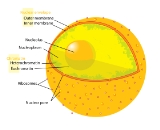
Endomembrane system
Overview
The endomembrane system is composed of the different membranes that are suspended in the cytoplasm
within a eukaryotic cell
. These membranes divide the cell into functional and structural compartments, or organelles. In eukaryote
s the organelles of the endomembrane system include: the nuclear envelope
, the endoplasmic reticulum
, the Golgi apparatus
, lysosome
s, vacuole
s, vesicles
, and the cell membrane
. The system is defined more accurately as the set of membranes that form a single functional and developmental unit, either being connected together directly, or exchanging material through vesicle transport.
Cytoplasm
The cytoplasm is a small gel-like substance residing between the cell membrane holding all the cell's internal sub-structures , except for the nucleus. All the contents of the cells of prokaryote organisms are contained within the cytoplasm...
within a eukaryotic cell
Eukaryotic Cell
Eukaryotic Cell is an academic journal published by the American Society for Microbiology. The title is commonly abbreviated EC and the ISSN is 1535-9778 for the print version, and 1535-9786 for the electronic version....
. These membranes divide the cell into functional and structural compartments, or organelles. In eukaryote
Eukaryote
A eukaryote is an organism whose cells contain complex structures enclosed within membranes. Eukaryotes may more formally be referred to as the taxon Eukarya or Eukaryota. The defining membrane-bound structure that sets eukaryotic cells apart from prokaryotic cells is the nucleus, or nuclear...
s the organelles of the endomembrane system include: the nuclear envelope
Nuclear envelope
A nuclear envelope is a double lipid bilayer that encloses the genetic material in eukaryotic cells. The nuclear envelope also serves as the physical barrier, separating the contents of the nucleus from the cytosol...
, the endoplasmic reticulum
Endoplasmic reticulum
The endoplasmic reticulum is an organelle of cells in eukaryotic organisms that forms an interconnected network of tubules, vesicles, and cisternae...
, the Golgi apparatus
Golgi apparatus
The Golgi apparatus is an organelle found in most eukaryotic cells. It was identified in 1898 by the Italian physician Camillo Golgi, after whom the Golgi apparatus is named....
, lysosome
Lysosome
thumb|350px|Schematic of typical animal cell, showing subcellular components. [[Organelle]]s: [[nucleoli]] [[cell nucleus|nucleus]] [[ribosomes]] [[vesicle |vesicle]] rough [[endoplasmic reticulum]]...
s, vacuole
Vacuole
A vacuole is a membrane-bound organelle which is present in all plant and fungal cells and some protist, animal and bacterial cells. Vacuoles are essentially enclosed compartments which are filled with water containing inorganic and organic molecules including enzymes in solution, though in certain...
s, vesicles
Vesicle (biology)
A vesicle is a bubble of liquid within another liquid, a supramolecular assembly made up of many different molecules. More technically, a vesicle is a small membrane-enclosed sack that can store or transport substances. Vesicles can form naturally because of the properties of lipid membranes , or...
, and the cell membrane
Cell membrane
The cell membrane or plasma membrane is a biological membrane that separates the interior of all cells from the outside environment. The cell membrane is selectively permeable to ions and organic molecules and controls the movement of substances in and out of cells. It basically protects the cell...
. The system is defined more accurately as the set of membranes that form a single functional and developmental unit, either being connected together directly, or exchanging material through vesicle transport.
Unanswered Questions

